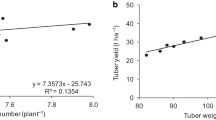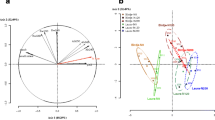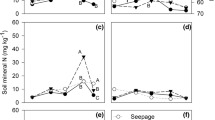Abstract
In hydroponics, nutrient management is the limiting factor to obtaining optimal production, and nitrogen (N) is the key component to consider when optimizing nutrient management in these types of systems. The objective of this study is to evaluate different combinations of N fertilizer concentrations in order to optimize the yield of basic seed potato minitubers in a three-phase hydroponic system. Treatments consisted of five combinations of N concentrations, applied before and after 21 days after plant transplant as follows, respectively: 1) 13 and 13, 2) 13 and 0, 3) 13 and 7.8, 4) 13 and 16, and 5) 13 and 26 mmol L−1. Propagation was performed by transplanting 3–4 cm potato plantlets cv. Agata from sprouts. There were significant effects of N treatments on all measured variables (root, leaf, stem, and plant dry weight and minituber number and weight). To obtain the maximum minituber number yield, 9.51 minitubers/plant, corresponding to 67 minitubers/m2, post 21-day adjusted N concentration was 18.4 mmol/L. Treatment 4 promoted higher basic seed potato minituber yield in a three-phase hydroponic system.
Resumen
En hidroponía, el manejo de los nutrientes es el factor limitante para la obtención de producción óptima, y el nitrógeno (N) es el componente clave a considerar cuando se optimiza el manejo de nutrientes en estos tipos de sistemas. El objetivo de este estudio fue evaluar las diferentes combinaciones de concentraciones de fertilizante nitrogenado a fin de optimizar el rendimiento de minitubérculos de semilla básica de papa en un sistema hidropónico trifásico. Los tratamientos consistieron de cinco combinaciones de concentraciones de N, aplicados antes y después de 21 días del trasplante, de la siguiente manera, respectivamente: 1) 13 y 13, 2) 13 y 0, 3) 13 y 7.8, 4) 13 y 16, y 5) 13 y 26 mmol L-1. Se efectuó la propagación mediante el trasplante de plántulas de papa de 3–4 cm cv. Agata de brotes. Hubo efectos significativos de los tratamientos de N en todas las variables medidas (peso seco de raíz, hoja, tallo y planta, y número y peso de minitubérculos). Para obtener el número máximo de minitubérculos de rendimiento, 9.51 minis/planta, correspondiendo a 67 minis/m2, la concentración ajustada de N posterior a los 21 días fue de18.4 mmol/l. El tratamiento 4 promovió el más alto rendimiento de minitubérculos de semilla básica de papa en un sistema hidropónico trifásico.
Resumo
Na hidroponia, o gerenciamento de nutrientes é o fator limitante para a obtenção de produção ótima sendo o nitrogênio (N) o componente chave a ser considerado ao otimizar o gerenciamento de nutrientes nesses sistemas. Assim, o objetivo desse trabalho foi avaliar diferentes combinações de concentrações de nitrogênio para a otimização da produtividade de tubérculos de batata-semente básica em sistema hidropônico de três fases. Os tratamentos consistiram de cinco combinações de concentrações de N até 21 dias após o transplante (DAT) e após 21 DAT (13 e 13 - controle; 13 e 0; 13 e 7,8; 13 e 16; 13 e 26 mmol L−1). O material de propagação utilizado foi broto da cultivar Ágata, com 3 a 4 cm de comprimento, em média. Houve efeito significativo dos tratamentos com N sobre todas as variáveis avaliadas (matérias de raiz, folha, caule e planta secas e número e massa de minituberculos). Para obter o número máximo de minitubérculos na colheita, 9,51 minitubérculos/planta, correspondendo a 67 minitubérculos/m2, a concentração de N ajustada foi de 18,4 mmol/L. O tratamento 4 propiciou a mais alta colheita de minituberculos da classe básica de batata-semente em um sistema hidropônico trifásico.






Similar content being viewed by others
References
Andriolo, J.L. 2006. Sistema hidropônico fechado com subirrigação para produção de minitubérculos de batata. In: Simepósio de Melhoramento Genético e Previsão de Epifitias em Batata, Santa Maria. Anais, UFSM.
Buckseth, T., A.K. Sharma, K.K. Pandey, B.P. Singh, and R. Muthuraj. 2016. Methods of pre-basic seed potato production with special reference to aeroponics – A review. Scientia Horticulturae 204: 79–87. https://doi.org/10.1016/j.scienta.2016.03.041.
Chang, D.C., and Y.B. Lee. 2016. Response of potatoes to different nutrient solution management in a closed hydroponic system. Response of potatoes to different nutrient solution management in a closed hydroponic system. Journal of Plant Nutrition 39 (11): 1547–1555. https://doi.org/10.1080/01904167.2015.1109120.
Davidson, R.D. and K. Xie. 2014. Seed potato production. In: Navarre, R. and Pavek, M.J. (eds.). Chapter 8. Wallingford; Oxfordshire, UK; Boston, MA: CAB International. pp. 115-132. ISBN: 978-1-78064-280-2.
Diaz, B.C. and C.A. Medeiros. 2005. Produção hidropônica de sementes pré-básicas de batata em diferentes concentrações de nitrogênio na solução nutritiva. http://www.abhorticultura.com.br/biblioteca/arquivos/Download/Biblioteca/45_0464.pdf (Accessed in July 4, 2011).
Factor, T.L., J.A.C. Araujo, F.P.C. Kawakami, and V. Iunck. 2007. Produção de minitubérculos de batatasemente em sistemas hidropônicos NFT, DFT e Aeroponia. Horticultura Brasileira 25: 082–087.
Fontes, P.C.R. 2005. Cultura da batata. In Olericultura: teoria e prática, ed. P.C.R. Fontes. Suprema: Viçosa.
Fontes, P.C.R., H. Braun, M.C.C. Silva, F.S. Coelho, P.R. Cecon, and F.L. Partelli. 2016. Tuber yield prognosis model and agronomic nitrogen use efficiency of potato cultivars. Australian Journal of Crop Science 10:933-939. https://doi.org/10.21475/ajcs.2016.10.07.p7404.
Goffart, J.P., M. Olivier, and M. Frankinet. 2008. Potato crop nitrogen status assessment to improve N fertilization management and efficiency: Past-present-future. Potato Research 51: 355–383.
Hakeem, K.R., M. Sabir, M. Ozturk, M.S. Akhtar, and F.H. Ibrahim. 2016. Nitrate and nitrogen oxides: Sources, health effects and their remediation. In: de Voogt P. (eds) Reviews of environmental contamination and toxicology, volume 242. Reviews of environmental contamination and toxicology (continuation of residue reviews), vol 242. Springer, Cham. https://doi.org/10.1007/398_2016_11.
Ho, T.V., N.T. Hoa, T.T. Loan, L.T. Tuyet, and P. Vander Zaag. 1988. Techniques for using sprouts for potato production in the tropics. Potato Research 31: 379–383. https://doi.org/10.1007/BF02357872.
Kelling, K.A., R.F. Hensler, and P.E. Speth. 2015. Importance of early-season nitrogen rate and placement to russet Burbank potatoes. American Journal of Potato Research 92: 502–510. https://doi.org/10.1007/s12230-015-9464-6.
Klossterman, B. and B. Bachem. 2014. The potato botany, production and uses. In: Navarre, R. and Pavek, M.J. (eds.). Chapter 4. Wallingford; Oxfordshire, UK; Boston, MA: CAB International. pp. 45-63. ISBN: 978-1-78064-280-2.
Kooman, P.L., M. Fahem, P. Tegera, and A.J. Haverkort. 1996. Effects of climate on different potato genotypes 1. Radiation interception, total and tuber dry matter production. European Journal of Agronomy 5: 193–205.
Krauss, A., and H. Marschner. 1982. Influence of nitrogen nutrition, daylength and temperature on contents of gibberellic and abscisic acid and on tuberization in potato plants. Potato Research 25: 13–21.
Mäck, G., and J.K. Schjoerring. 2002. Effect of NO3 − supply on N metabolism of potato plants (Solanum tuberosum L.) with special focus on the tubers. Plant. Cell and Environment 25: 999–1009. https://doi.org/10.1046/j.1365-3040.2002.00892.x.
Martinez, H.E.P., and J.B. Silva Filho. 2006. Introdução ao cultivo hidropônico de plantas. 3ª ed. Editora UFV: Viçosa.
Mori, K., K. Asano, S. Tamiya, T. Nakao, and M. Mori. 2015. Challenges of breeding potato cultivars to grow in various environments and to meet different demands. Breeding Science 65: 3–16. https://doi.org/10.1270/jsbbs.65.3.
Muller, D.R., D.A. Bisognin, J.L. Andriolo, J. Dellai, and F. Copetti. 2007. Produção hidropônica de batata em diferentes concentrações de solução nutritiva e épocas de cultivo. Pesquisa Agropecuária Brasileira 42: 647–653.
Muttucumaru, N., A.J. Keys, M.A. Parry, S.J. Powers, and N.G. Halford. 2014. Photosynthetic assimilation of 14C into amino acids in potato (Solanum tuberosum) and asparagine in the tubers. Planta 239: 161–170. https://doi.org/10.1007/s00425-013-1967-0.
Oliveira, C.A.S. 2000. Potato crop growth as affect by nitrogen and plant density. Pesquisa Agropecuária Brasileira 35: 939–950. https://doi.org/10.1590/S0100-204X2000000500011.
Oraby, H., A. Lachance, and Y. Desjardins. 2015. A low nutrient solution temperature and the application of stress treatments increase potato mini-tubers production in an aeroponic system. American Journal of Potato Research 92: 387–397. https://doi.org/10.1007/s12230-015-9444-x.
OSCS – Oregon Seed Certification Service. 2018. 2018 Oregon potato seed certification standards. Corvallis: Oregon State University.
Otazú, V. 2010. Manual on quality seed potato production using aeroponics. Peru: International Potato Center (CIP), Lima.
Patrick, J.W., and K. Colyvas. 2014. Crop yield components – Photoassimilate supply- or utilisation limited-organ development? Functional Plant Biology 41: 893–913. https://doi.org/10.1071/FP14048.
Paul, S., M.K. Das, P. Baishya, A. Ramteke, M. Farooq, B. Baroowa, R. Sunkar, and N. Gogoi. 2017. Effect of high temperature on yield associated parameters and vascular bundle development in five potato cultivars. Scientia Horticulturae 225: 134–140. https://doi.org/10.1016/j.scienta.2017.06.061.
Pereira, A.B., and N.A. Villa Nova. 2008. Potato maximum yield as affected by crop parameters and climatic factors in Brazil. HortScience 43 (5): 1611–1614.
Rahman, M.S., and A.M. Akanda. 2009. Performance of seed potato produced from sprout cutting, stem cutting and conventional tuber against PVY and PLRV. Bangladesh Journal of Agricultural Research 34 (4): 609–622.
Sampaio, J.F., Jr., P.C.R. Fontes, M.A. Guimarães, and M.A. Moreira. 2009. Produção de mini-tubérculos de batata propagada por brotos, em função de doses de nitrogênio aplicadas ao substrato. Bioscience Journal 25: 75–82.
Silva, J.G., M.G.C. França, F.T.F. Gomide, and J.R. Magalhães. 2013. Different nitrogen sources affect biomass partitioning and quality of potato production in a hydroponic system. American Journal of Potato Research 90: 179–185. https://doi.org/10.1007/s12230-012-9297-5.
Sonnewald, S., and U. Sonnewald. 2014. Regulation of potato tuber sprouting. Planta 239: 27–38. https://doi.org/10.1007/s00425-013-1968-z.
Souza, C.B.S., P.C.R. Fontes, M.A. Moreira, M. Puiatti, H.E.P. Martinez, and R.F. Araújo. 2012. Production of basic potato seed minitubers in substrate and different nitrogen rates. Revista Ceres 59: 850–858. https://doi.org/10.1590/S0034-737X2012000600016.
Stitt, M., C. Müller, P. Matt, Y. Gibon, P. Carillo, R. Morcuende, W.R. Scheible, and A. Krapp. 2002. Steps towards an integrated view of nitrogen metabolism. Journal of Experimental Botany 53: 959–970. https://doi.org/10.1093/jexbot/53.370.959.
Virtanen, E., and J. Tuomisto. 2017. Hydroponic minituber production in growth room conditions and carry-over effects of the technique on produced minitubers. Journal of Agricultural Science 9: 41–48. https://doi.org/10.5539/jas.v9n1p41.
Wang, M., Q. Shen, G. Xu, and S. Guo. 2014. Chapter one - new insight into the strategy for nitrogen metabolism in plant cells. In: International review of cell and molecular biology. Jeon, K.W. (ed.). Academic Press 310:1–37. https://doi.org/10.1016/B978-0-12-800180-6.00001-3.
Wang, C.C., X.Y. Wang, K.X. Wang, J.J. Hu, M.X. Tang, W. He, and P. Vander Zaag. 2018. Manipulating aeroponically grown potatoes with gibberellins and calcium nitrate. American Journal of Potato Research 59: 1–11. https://doi.org/10.1007/s12230-018-9635-3.
Acknowledgements
We thank the Brazilian National Council for Scientific and Technological Development (CNPq), Coordination for the Improvement of Higher Education Personnel (CAPES), and Foundation of Support Research of the State of Minas Gerais, Brazil (FAPEMIG) for their financial support.
Author information
Authors and Affiliations
Corresponding author
Rights and permissions
About this article
Cite this article
da Silva Filho, J.B., Fontes, P.C.R., Martinez, H.E.P. et al. Varying Nitrogen Concentrations to Optimize Basic Seed Potato Minitubers Production in a Three-Phase Hydroponic System. Am. J. Potato Res. 95, 687–695 (2018). https://doi.org/10.1007/s12230-018-9676-7
Published:
Issue Date:
DOI: https://doi.org/10.1007/s12230-018-9676-7




